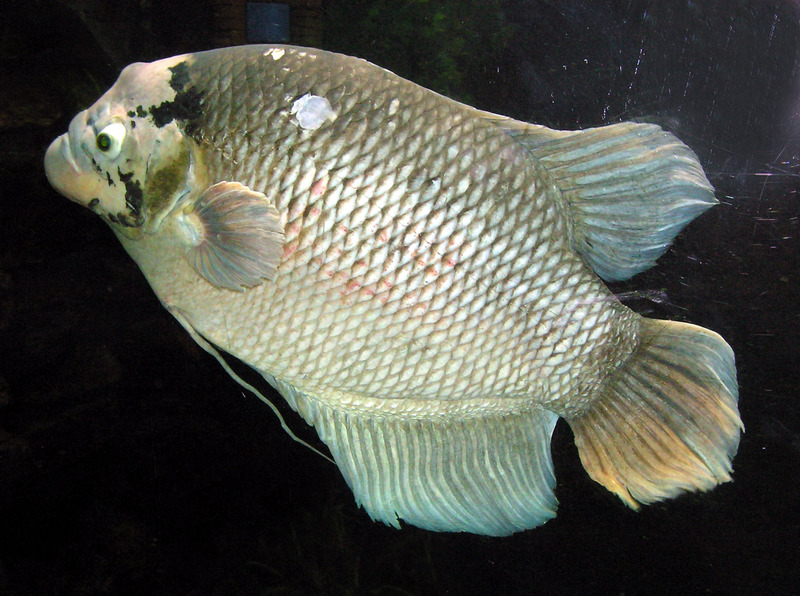Giant gourami
From Wikipedia, the free encyclopedia
[Photo] Giant gourami (Osphronemus goramy) at Bristol Zoo, Bristol, England. Photographed by Adrian Pingstone in December 2005.
The Giant Gourami (Osphronemus goramy) is a gourami, a freshwater fish belonging to the family Osphronemidae. Some other larger members of this family are also occasionally or regionally referred to as "giant gouramis", including the banded gourami, Polyacanthus fasciatus, and the three spot gourami, Trichogaster trichopterus. In turn the giant gourami is also sometimes known as the banded gourami, rainbow gourami, or striped gourami.
Giant Gourami build nests using weeds and twigs. Female Giant Gourami can be identified by their thicker lips. The Giant Gourami is native to parts of Indochina, Malaysia and Indonesia, but has been introduced elsewhere for the purpose of aquaculture.
It lives in fresh or brackish water, particularly slow-moving areas such as swamps, lakes and large rivers. It is capable of breathing moist air, so can survive out of water for long periods. It is much larger than most gouramis, growing to a maximum length of 70 cm (28 inches). In colour it is a pale to golden yellow, with silvery pale blue stripes running vertically along its body.
Partly in consequence of its size, the Giant Gourami is a significant food fish; in some parts of India, for example, it is dried and then eaten. In some of the South East Asian countries where it is native, there are aid programs promoting the 'domestication' of these fish, while in its native regions it is been harvested as a customary food source. The species has also been used for control as they can be voracious vegetarians.
In aquarium
Tank specifications
The Giant Gourami is also popular in aquaria.Contrary to popular "knowledge", Giant Goramies, or any fish for that matter, do not grow to "environmental" size, but they can be held in tanks any where from 125 (us gallons) up. Preferably the tank should have a dark bottom, and densely planted edges. There should be plenty of room left in the center of the tank for the Gourami to swim. They prefer the company of other fish which are of a similar size and temperament. They will be most easy to keep at 3 months old at around 75 mm or 3".
At this age they will have a pronounced beak. They can grow rapidly given sufficient diet and space to move. Even under less than ideal conditions, Gourami can grow from 75 mm to 500 mm in four years. At this age, in addition to the rounded face, a mature Giant Gourami would have begun to develop the hump just above their eyes.
The Gourami, in a community tank, will snap and charge any other fish which are small enough for it to bully. Like most aquaria dwellers, Giant Gourami will consider existing co-habitants as part of the furniture and so can be quickly raised with larger more passive fish. However, if other fish are added to a tank, either large or small, they might be killed within a short period.
Diet
Gourami tend towards vegetarianism, preferring algae-based foods but will eat meaty foods. An algae-based flake food, along with freeze-dried bloodworms, tubifex, and brine shrimp will provide these fish with the proper nutrition while young. Once of significant size, they can be fed legumes, part or fully cooked fibrous or starchy vegetables, or fresh (or off) fruits. They do develop tastes, such as an aversion to acidic or strongly flavoured foods such as tomatoes or onions, or fresh stone fruit or citrus.
Breeding
The Giant Gourami is an egg layer and the male will build a bubblenest before spawning. The male and female are distinguished by the dorsal fins and body color. The dorsal fin on the male ends in a point, and the body is darker changing to nearly black during spawning. When breeding, the water in the tank should be decreased to about 20 cm (8 inches) deep and the temperature should be 28 °C (82 °F). After spawning the female should be removed to a separate tank as the male will jealously guard the eggs, in a captive environment, sometimes becoming aggressive towards the female. The eggs will hatch in 24 hours.
http://en.wikipedia.org/wiki/Giant_gourami
| The text in this page is based on the copyrighted Wikipedia article shown in above URL. It is used under the GNU Free Documentation License. You may redistribute it, verbatim or modified, providing that you comply with the terms of the GFDL. |
|

